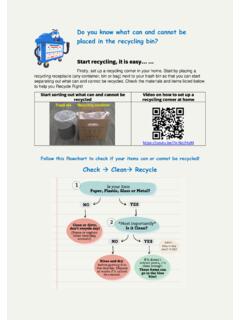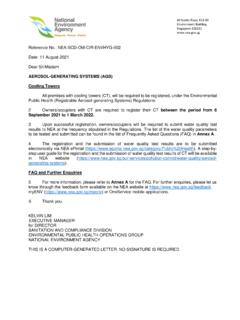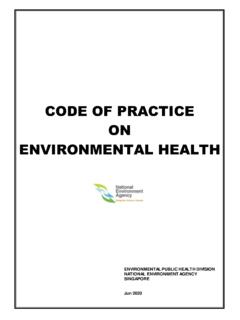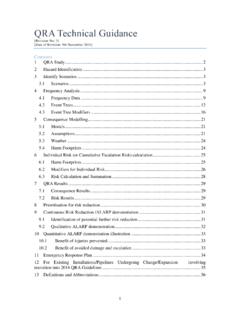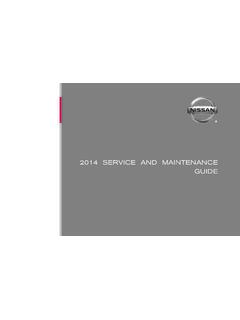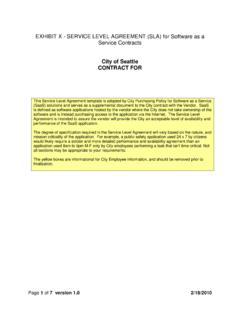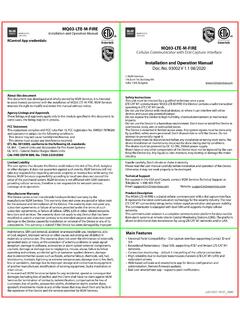Transcription of A Guide to Better Public Toilet Design and Maintenance
1 A Guide to Better Public Toilet Design and Maintenance158A Guide To BetterPublic ToiletDesign and MaintenanceA Publication by The Restroom Association (Singapore)In Partnership withThe National Environment AgencyA Guide To BetterPublic ToiletDesign and MaintenanceA Publication by the Restroom Association (Singapore)In Partnership withThe National Environment Guide to Better Public Toilet Design and Maintenance2 CONTENTSPAGE OF A WELL DESIGNED Toilet 3I) Design Introduction5 Layout5 Lighting7 Materials7 Urinals9 Water Closets9 Wash Basins10 Provision of Facilities11 Special Needs11 Installation Standards12 Ventilation System12 Looscaping14II) Maintenance Sequence of Cleaning15 Schedule Cleaning16 Timing and Frequency of Cleaning16 Basic Equipment and Supplies16 Correct Use of Cleaning Agents17 Mechanical Ventilation System17 Training17 Performance-Based Contracts17 III)
2 USER EDUCATION Persuading Users to do their part18 Message Design18 Message Placement18 ILLUSTRATIONS21 39 APPENDICES40 55 SUGGESTED LAYOUT OF Public TOILETS56 59DO S AND DON TS IN DESIGNING TOILETS60 69 ACKNOWLEDGEMENTS70A Guide to Better Public Toilet Design and Maintenance3 IntroductionIn recent years, thanks to various publicity programmes, the issue of Public Toiletshas evolved from being an embarrassing subject to one that is gaining widespreadawareness and we ask "Why is the Toilet Dirty? we trace its origin to many diverse and inter-related Toilet issues including Design , Behaviour, Public Health, SocialGraciousness, Cleaning Skills and Methods, Building Maintenance , Accessibility,Setting Norms and Standards, Legislation, Research & Development, Technologies, Public Education and Environmental issues such as issues are also different in each kind of building a factory's Toilet servesdifferent visitors than that of a shopping centre, or a school, a hospital, an office, acoffee shop, Toilet needs of a man are also different from a woman, a child, an elderlyperson, an infant and different kinds of handicapped people like the visuallyhandicapped, blind, wheel-chair bound, etc.
3 Furthermore, ethnic and cultural needsalso have to be first Guidebook for Better Public Toilet Design and Maintenance was firstpublished in 1999. As an ongoing effort to update our knowledge base on thesubject, we are glad to bring you this second edition. As we continue to search foranswers to our Toilet issues, we hope you'll be able to use these information in yourdesign and Maintenance , and offer our society a more predictably pleasant Toiletenvironment for their next SimPresidentRestroom Association (Singapore)A Guide to Better Public Toilet Design and Maintenance4 Definition of A Well Designed Toilet Anyone, who has even been in an overcrowded or uncomfortable Public Toilet , willvalue a good Toilet Design . The usual demands placed on a high-profile, high trafficand heavily used facility requires extra thoughts for each process.
4 A well-designedpublic Toilet has to be:(a) Clean and dry(b) Well ventilated(c) Easy to maintain(d) Carefully planned layout(e) Handicap friendlyThere are various types of toilets:1. Public toilets provided by shopping centres, supermarkets, wetmarkets, eating establishments, food centres, bars, nightclubs,conference halls, cinemas, theatres, parks, tourist sites, publicresorts, piers, bus terminals, MRT stations, stadia, Public swimmingpools and petrol stations. Use of these facilities is generally open toany member of the Public or restricted to the patrons of the ownerof the Private toilets for staff in offices, factories or occupants of buildingswhere the use is restricted to patrons of the service provider or bythe building Private Residences (This is beyond the scope of this guidebook) Public toilets are places where one is obliged to ease oneself in unfamiliarsurroundings among the strangers of the same sex.
5 Therefore, the fundamentalprinciples of Design of toilets include psychological studies and not just physicalclearances and space Guide to Better Public Toilet Design and number of different activity spaces are shown in the diagram (See Illustration 1):space occupied by the appliances itself, additional space required by the user andfurther space for their own belongings or circulation within the toilets. In many cases,these latter spaces may overlap on occasion. Common sense will dictate when thisis appropriate and when it is the appliances in order of use simplifies the circulation and reduces thedistance travelled by the user. Using sensor-operated appliances should is difficult and costly to insulate the toilets acoustically and this problem can beresolved by planning isolation as much as unsupervised installation can prevent vandalism.
6 Even with the most vandal-resistant appliances, an unsupervised facility will eventually become most cases, facility engineers and cleaners play an important role, which willresult in well-maintained toilets. However, all designs should allow for individualitems to be replaced. Pipe work, traps and electrical supplies should be concealedfor aesthetic and hygiene entrance/exit plans work satisfactorily provided the path of the users do notcross each other and the entrance is wide enough. Dispensing with the entrancedoor to the Public Toilet not only helps to improve the ventilation within the Toilet butalso minimizes hand contact for hygiene reasons (See Illustration 2). In many toilets,doors have been replaced by offset entrance maze which blocks the view yet allowseasier, hands-free access.
7 This approach eliminates the need for automatic doorsand thus meeting stringent disability access Guide to Better Public Toilet Design and Maintenance6 Public toilets should be designed to minimise hand contact as far as possible forhygienic reasons. Electronic products for toilets such as flush valves and faucetsrequire minimum Maintenance but offer enhanced operations that promotesanitation and perceived cleanliness because of hands-free are several screening arrangement for installations showing the visibility fromoutside in each case (See Illustration 3). Consideration should be given to thepositioning of the mirrors and to the gaps created by the example, the access entrance to male Public toilets should not open directly tothe urinal area. Avoid entrances opening onto a wall surface with the mirrorreflecting the urinals.
8 (See Illustration 4)Directional signs leading to the toilets should meet the needs of the HandicapWelfare Association (HWA). The detailed requirements can be found in Building andConstruction Authority s (BCA) Code for Barrier-Free Accessibility in Buildings (See Illustration 5). Location of toilets should not be too remote from main trafficarea to avoid long distance walking for the aged with weak knees. It has to be easilyaccessible for those with urgency and for Better personal safety for the to this, signages used should be sufficient and prominently displayed in allmain traffic passageways, so that the user does not need to ask for used should show contrast of dark solid figure against a white backgroundand significant to be seen by the visually handicapped and the aged. Fancy signageusing Queen and King or Hat , High-heel shoes are confusing and should notbe encouraged.
9 It is not easily distinguished by the visually handicapped and ratio of fittings in male and female toilets should be 1 & 1 Urinal for male: for far as possible, fixtures such as urinals and should be fitted back-to-backwith common pipe ducts in Guide to Better Public Toilet Design and Maintenance7 All Public toilets should be mechanically ventilated. Small Public toilets should befitted with an exhaust fan as well-designed lighting system will save electrical energy and improve theappearance of the Toilet . Poorly designed fixtures with discoloured diffusers go along way to make a Toilet dingy. Dark and shadowy, off-coloured lighting can createthe impression that a Toilet isn t lighting can be used to help create a softer, friendlier environment. Harshlighting can create a cold and unwelcoming air while being inappropriate for thetasks being performed.
10 It can also highlight hard-to-clean areas. Thoughtful selectionof fixtures and lamps coupled with careful placement is essential (Refer to Illustration6 and 7 for examples).All Public toilets should be provided with warm-colour lighting for general lighting aswell as down lights above the wash basin/mirror (Refer to Illustration 8 forexamples). The minimum general lighting level is 300 lighting aids in creating a Better ambience in the toilets, which in turnencourages more care and responsibility from the used should be durable and resistant to vandalism and neglect. Appliedfinishes such as paint should be of good materials: -(a) FloorNon-slip ceramic tiles, natural stone, homogeneous tiles, terrazzo.(b) WallCeramic tiles, natural stone, homogeneous tiles, stainless steel, enamelledA Guide to Better Public Toilet Design and Maintenance8steel panels, glass block, aluminium panels, phenolic cladding.



